
User Manual
imagination at work
GE Digital Camera

User Manual
imagination at work
GE Digital Camera

WARNING
Do not expose the camera battery pack or other accessories to rain or humidity to prevent fire hazard or electric shock.
For customers in the U.S.A.
Tested To Comply With FCC Standards
FOR HOME OR OFFICE USE
FCC Statement
This device complies with part 15 of the FCC Rules. Operation is subject to the following two conditions:
(1) This device may not cause harmful interference, and (2) this device must accept any interference received, including interference that may cause undesired operation.
For customers in Europe
"CE" mark indicates that this product complies with the European requirements for safety, health,
environment and customer protection. "CE" marked cameras are intended for sales in Europe.
This symbol
 electronic equipment in the European countries. Please do not throw the equipment into the domestic refuse. Please use the return and collection systems available in your country for the disposal of this product.
electronic equipment in the European countries. Please do not throw the equipment into the domestic refuse. Please use the return and collection systems available in your country for the disposal of this product.
Declaration of Conformity
Customer Service Telephone Number:
following the provision of the EMC Directive (89/336/ EEC,2004/108/EEC)
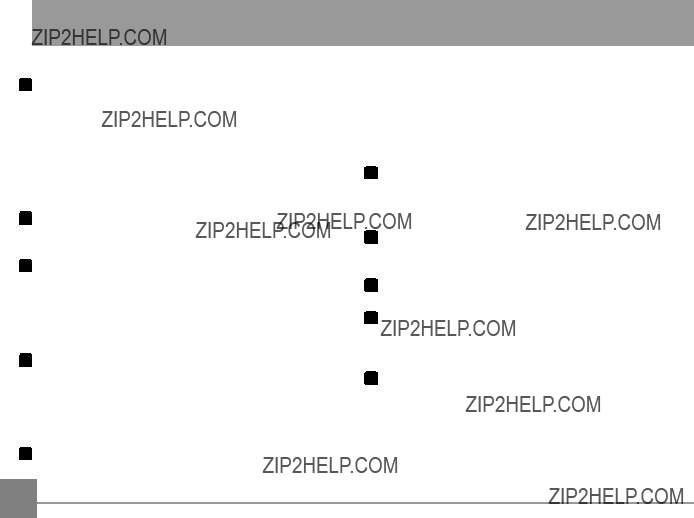
SAFETY PRECAUTIONS
Camera notes:
Do not store or use the camera in the following types of locations:
???In the rain, very humid and dusty places.
???In a place where the camera can be exposed directly to the sunlight or subject to high temperature, e.g. Inside a closed car in summer.
???In a place where the camera is subject to a high magnetic field, e.g. near motors, transformers or magnets.
Do not place the camera on a wet surface or places where dripping water or sand may come in contact with the camera, which may cause irrepairable faults.
If the camera will not be used for a long period of time, we suggest you remove the battery and the memory card from the camera and keep them in dry environment.
 If you carry the camera suddenly from a cold location to a warm place, moisture may condense inside the camera. We suggest you wait for a while before turing on the camera.
If you carry the camera suddenly from a cold location to a warm place, moisture may condense inside the camera. We suggest you wait for a while before turing on the camera.
No compensation for loss of recordings. Loss of recordings cannot be compensated for if a malfunction of your camera or recording media, etc, makes the playback of recordings not possible.
Battery notes:
Incorrect use of the batteries may cause them to leak, become hot, ignite or burst. Always observe the precautions given below.
ii
???Do not expose the batteries to water, and take particular care to keep the terminals dry.
???Do not heat the batteries or throw them into a fire.
???Do not attempt to deform, disassemble or modify the batteries.
 Keep the batteries out of reach of babies and small children.
Keep the batteries out of reach of babies and small children.
In cold locations, battery performance deteriorates and the time for which they can be used shortens markedly.
Memory card notes:
When using a new memory card, or a memory card has been initialized by a PC, be sure to format the card with your digital camera before using it.
To edit image data, copy the image data to the PC???s hard disk first.
Do not change or delete the folder names or file names in the memory card from your PC, as this may make it impossible to recognize or misinterpret the original folder or file in your camera.
The photos taken by this camera are stored in the auto- generated folder in SD card. Please do not store photos that are not taken by this model of camera, as this may make it impossible to recognize the picture when the camera is in playback mode. Please do not expose the camera to harsh environments such as moisture or extreme temperatures, which may shorten the life of your camera or damage the batteries.

BEFORE YOU START
Preface
Thank you for purchasing this GE digital camera. Please read this manual carefully and keep it in a safe place for future reference.
Copyright
?? Copyright 2010 General Imaging Company All rights reserved.
No part of this publication may be reproduced, transmitted, transcribed, stored in a retrieval system, or translated into any language or computer language, in any form, by any means, without the prior written permission of General Imag- ing Company.
Trademarks
All trademarks mentioned in this manual are used for identi- fication purposes only and are properties of their respective owners.
Safety information
Please read the following important information carefully before using the product.
???Do not take apart or attempt to service the camera your- self.
???Do not drop or knock the camera. Improper handling may damage the product.
???Turn off the camera before inserting or removing the bat- tery and memory card.
???Use only the type of battery that come with the camera. Using other types of batteries may damage the camera and invalidate the warranty.
???Do not touch the camera lens.
???Please not expose the camera to harsh environments such as moisture, or extreme temperatures, which may shorten the life of your camera or damage the batteries.
???Do not use or store the camera in dusty, dirty, or sandy areas, as its components may be damaged.

???Do not expose the lens to direct sunlight for extended periods.
???Download all pictures and remove the batteries from the camera if you are going to store the camera for long periods of time.
???Do not use abrasive cleansers,
About this manual
This manual provides you with instructions on how to use your
GE digital camera. Every effort has been made to ensure that the contents of this manual are accurate, however General Imaging Company reserves the right to make changes without notice.
Symbols used in this manual
Throughout this manual, the following symbols are used to help you locate information quickly and easily:
 Indicates the useful information to know.
Indicates the useful information to know.
Indicates precautions to be taken while operating the camera.

CONTENTS
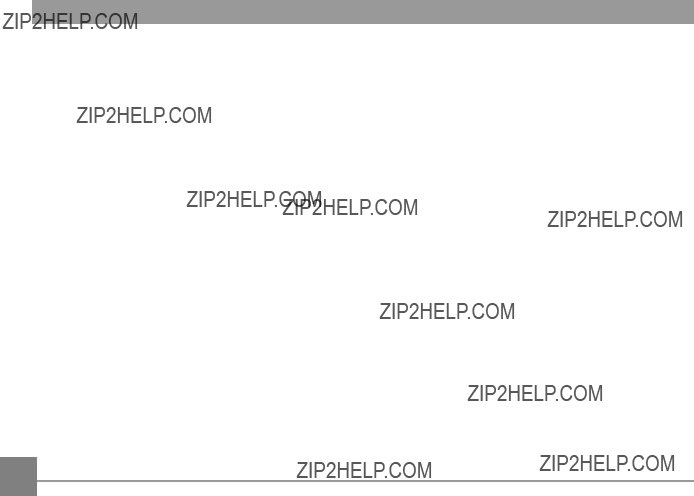


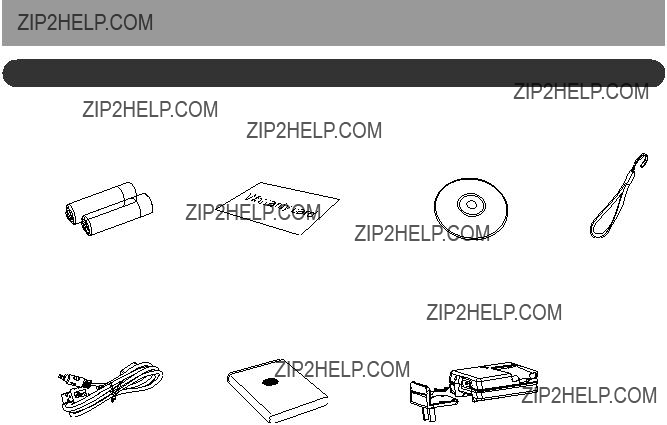
GETTING READY
Unpacking
Your package should contain the camera model you purchased along with the following items. If anything is missing or appears to be damaged, please contact your vendor.
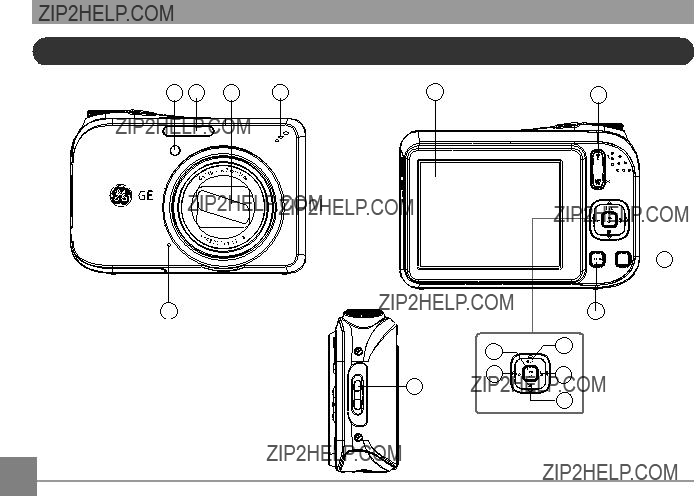
Camera Views: A Series
 8
8
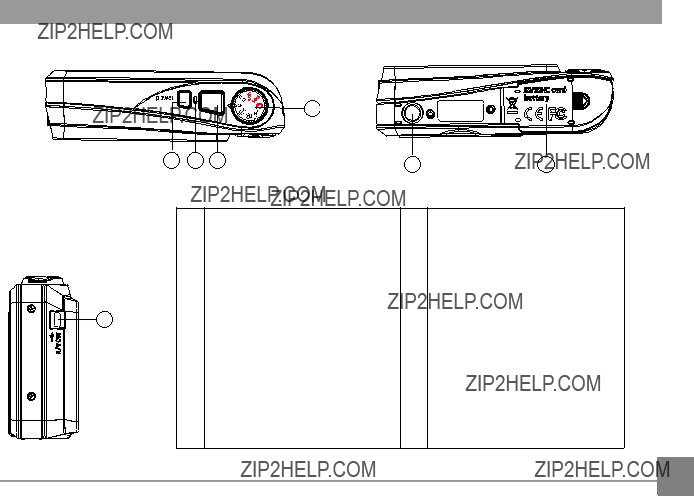
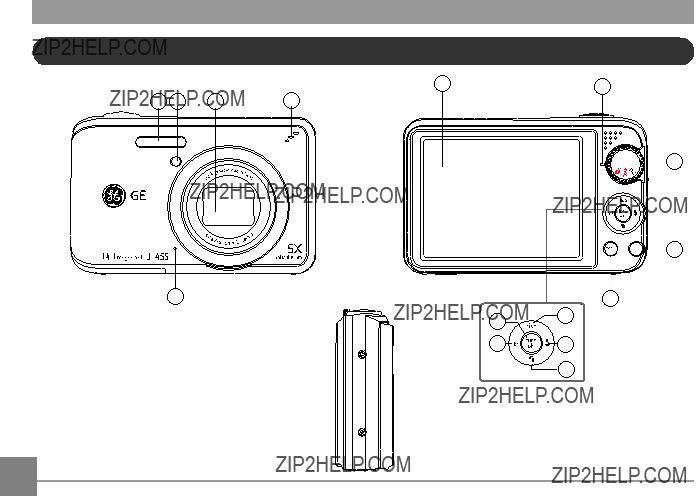
Camera Views: J Series
 8
8
 9
9
10

Left View
16
17
20 19 182221
11

Charging the Battery (J Series)
1.Place the battery into the charger as shown.
2.Plug the one end of the connecting cable (plug adapter) into the charger base (the plug adapter may vary in different countries, please subject to the actual object).
3.Plug the other end of the connecting cable into a the wall outlet.
1
2
Leave the battery to charge until the charger light turns green. (To maximize battery life, the first charge should be at least 4 hours)
 The charger is for indoor use only.
The charger is for indoor use only.
12

Insert the Battery and SD/SDHC Card (Not included) (A Series)
1. Open the battery compartment.
2.Insert the enclosed batteries into the battery slot in the correct direction.
13

3.Insert an SD/SDHC card (not included) into the memory card slot as shown.
4. Close the battery compartment.
14

Insert the Battery and SD/SDHC Card (Not included) (J Series)
1. Open the battery compartment.
2.Insert the battery while observing the correct polarity. Use the side of battery to press down the stopper as shown, allowing the battery lock into place properly.
15

3.Insert an SD/SDHC card (not included) into the memory card slot as shown.
4. Close the battery compartment.
16

Optional SD/SDHC cards are not included. The use of 64 MB to 16 GB memory cards from recognized
manufacturers such as SanDisk, Panasonic and Toshiba is recommended for reliable data storage.
To remove the SD/SDHC card, open the battery compartment and gently push the card to release it. Pull the card out carefully.
Throughout the rest of the manual, the following illustrations show the A Series model as an example. The J Series models operate similarly.
Turning On and Off
Press the Power button to turn the camera on. To turn off the camera, press the Power button again.
Power Button
When the camera is turned on, it will be at the same shooting mode based on the last use. You can turn the Mode Dial on the top to select. When using the camera for the
17

Using the Mode Dial
The GE camera provides a convenient mode dial that allows you to switch between different modes with ease. All the available modes are listed as follows:
18

Setting Date/Time and Language
To set the language, date, and time, go to the following setup options in the Setup menu.
???Date / Time
???Language
To access the Setup menu, do the following:
1.Press Power to turn the camera on.
2.Press the 
 button, switch among the setting menus by using the Left/Right button to select the corresponding basic setting menu.
button, switch among the setting menus by using the Left/Right button to select the corresponding basic setting menu.
3.Press the  button to confirm the setting.
button to confirm the setting.
Setting the Date and Time
1.Use the Up/Down button to select Date/Time. Then press the Right button to enter the setting.
2.Press the Left/Right to highlight each field and use the Up/Down to adjust the value.
3.Press the  button to confirm the setting.
button to confirm the setting.
19

Setting the Language
1.Use the Up/Down button to go to the Language. Then press the Right button to enter the setting.
2.Use the Left/Right buttons to select the desired language.
3.Press the button to confirm the setting.
button to confirm the setting.
The Date/Time and Language setup will automatically appear when the camera is turned on the first time.
20
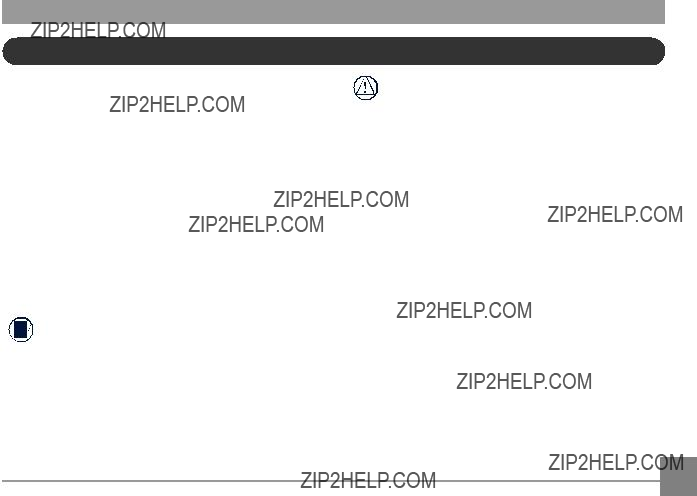
About the LCD Screen
When you turn the camera on, various icons are shown on the LCD screen to indicate the current camera settings and status. To learn more about the displayed icons, see ???LCD Screen display??? on page 29.
LCD Screen notes:
Extremely
Avoid exposing the LCD screen to water; please remove any moisture on the LCD screen with dry and soft cleaning cloth.
If the LCD monitor is damaged, take particular care with the liquid crystal in the monitor. If any of the following situations arise, take the recommended immediate action indicated below:
???If liquid crystal comes in contact with your skin, wipe the area with a cloth and then wash thoroughly with soap and running water.
???If liquid crystal gets into your eye, flush the affected eye with clean water for at least 15 minutes and then seek medical assistance.
???If liquid crystal is swallowed, flush your mouth thoroughly with water. Drink large quantities of water and induce vomiting. Then seek medical assistance immediately.
21

BASIC OPERATION
Auto mode is the easiest mode to take photos. While operating in this mode, the camera automatically optimizes your photos for best results.
To start shooting, do the following:
1.Press Power to turn the camera on.
2.Switch the Mode dial into Auto mode (  ).
).
3.Compose your picture on the LCD screen and press the Shutter button halfway to focus on the subject.
4.The LCD screen will show green focus frame after the subject is in focus.
5.Press Shutter fully to capture the image.
22
Your camera is built with two zoom functions: Optical Zoom and Digital Zoom. When shooting photo, you can zoom in or zoom out the shot subject by using Zoom button/zoom lever on the camera.
A SeriesJ Series
Zoom indicator (See ???Digital Zoom??? on page 51)
When the Optical Zoom is at the critical point, release the
Zoom button/zoom lever and then adjust it again, and the camera will switch between Optical Zoom and Digital Zoom automatically. After adjustment, the zoom display shaft will be hidden, and it displays  only to show it is in zoom status currently.
only to show it is in zoom status currently.

Basic Functions Menu
The Basic Function Menus of the camera include Flash, Self- timer, Macro Capture, and Exposure Compensation. The suitable function setting can let you shoot better photos.
Set the basic functions as per the following steps:
1.Pull up the Basic Function Menus by pressing Right/Flash button.
2.Select the basic function for setting by pressing Left/Right button.
3.Enter the selection by pressing Up button.
4.Select a setting by Left/Right button, press button to confirm the setting and exit menus, or return to the Basic
button to confirm the setting and exit menus, or return to the Basic
Functions Menu by pressing Down button.
Flash
???  Auto Flash
Auto Flash
Camera flash goes off automatically based on existing light conditions.
???
The camera exposes a brief flash before the picture is taken to reduce
???Forced Flash
Flash always goes off.
23
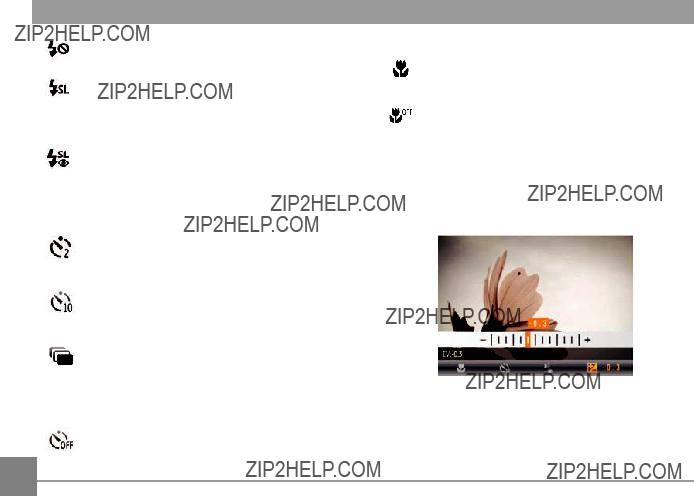
???Forced Off
Flash is turned off.
???Slow Synchro
This allows you to take pictures of people at night that clearly show both your subjects and the night time backdrop.
???
Using this mode for slow synchro shots with
???
A single picture is shot 2 seconds after the Shutter button is pressed.
???
A single picture is shot 10 seconds after the Shutter button is pressed.
???Continuous Shot
Pictures are shot continuously when the Shutter button is pressed down based on the Continuous Shot settings in the menu. (See ???Continuous Shot??? on page 49).
Macro Mode
???Macro
Select this to focus on subjects 5cm from the lens.
Select this option to disable Macro.
Exposure Compensation
The exposure compensation allows you to adjust the light exposure value and shoot the best photo.
The adjustable range of exposure value is from EV
24
Disable the

Advanced Functions Menu
The Advanced Functions Menu of the camera include Image
Size, Image Quality, White Balance, Image Color and ISO etc.
The suitable function setting can let you shoot better photos and videos.
Set the advanced functions as per the following steps:
1.Pull up the Advanced Function Menus by pressing button.
button.
4. Select a setting by Left/Right button, press button
button
to confirm the setting and exit menus, or return to the
Advanced Functions Menus by pressing Down button.
2.Select the advanced function for setting by pressing Left/ Right button.
3.Enter the selection by pressing Up button.
25

WB (White Balance)
The White Balance allows you to adjust the color temperature under different light source to ensure faithful color reproduction. (The WB setting is only available when the camera is in the M Manual mode).
The options of White Balance include:
ISO
The ISO function allows you to set the sensitivity of the camera sensor based on the brightness of the scene. To improve the performance in darker environments, a higher ISO value is required. On the other hand, a lower ISO value is needed when in bright conditions. (The ISO setting is only available when the camera is in the M Manual mode).
Pictures at higher ISO will naturally have more noise than those at lower ISO.
The options of ISO include automatic, 80, 100, 200, 400, 800 and 1600.
The available ISO values vary on different camera models.

Quality
The quality setting adjusts the compression ratio of the images. Higher quality settings give better photos, but will take up more memory space.
The picture quality of image has totally three options:
??? : Best
: Best
???  : Fine
: Fine
???  : Normal
: Normal
Size
The size setting refers to the image resolution in pixels. A higher image resolution allows you to print that image in larger sizes without degrading the image quality.
The bigger the number of recorded pixels is, the better the image quality becomes. As the number of recorded pixels becomes smaller, you will be able to record more frames on a memory card.
27

Color
The color setting allows you to add artistic effects directly when taking pictures. You can try different color tones to alter the mood of your pictures. (The Color setting is only available when the camera is in the M Manual mode).
The color options include:
???  Auto
Auto
???  Sepia
Sepia
???  Vivid
Vivid
28
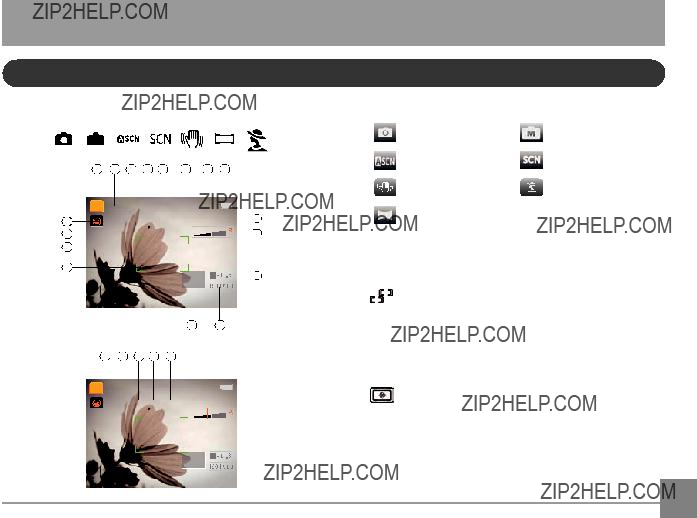
USING THE MODES
LCD Screen Display
Still Picture Mode Display
Mode:  M
M
2AF

3Expo Metering
 Spot
Spot
 Center
Center
AiAE
4Image Size
5Image Quality
29

6Remaining number of pictures
7Memory
8Battery Status
9WT Ratio (Displayed only when zoom is activated)
10Zoom
11Exposure
12 ISO Value (Adjustable only in M Manual Mode)
13Histogram
14Focus Frame
15Slow Shutter Warning
16Continuous Shot
17Face Detection
20Macro Mode
21
22Flash Mode
 Auto
Auto
Forced Flash
Forced Off
Slow Synchro
30

Video Shooting Mode Display
Mode : 
1Video Mode icon
2AF

3Metering  Spot
Spot
 Center
Center
 AiAE
AiAE
4Video Quality
5Focus Frame
6
7Remaining Time for Video Recording
8Memory
9Battery Status
10WT Ratio (Displayed only when zoom is activated)
11Zoom
12Exposure
13Recording Status Icon
 Recording standby
Recording standby
 Recording
Recording
For optimal video shooting, it is recommended that the SD card be used. If you shoot videos with the limited
During video shooting, the optical zoom is fixed but the highest 1.5x digital zoom is still available.
31

Playback mode display
Mode: 
 8
8  9
9
1.Play Mode icon
2.Picture File
3.File protection
4.Picture Number
5.Memory
6.Battery Status
7.Image Zoom
8.The current display area
9.Affecting regional
10.Memory Space (this picture/Total number of pictures)
11.Recording Date and Time
12.DPOF file
32
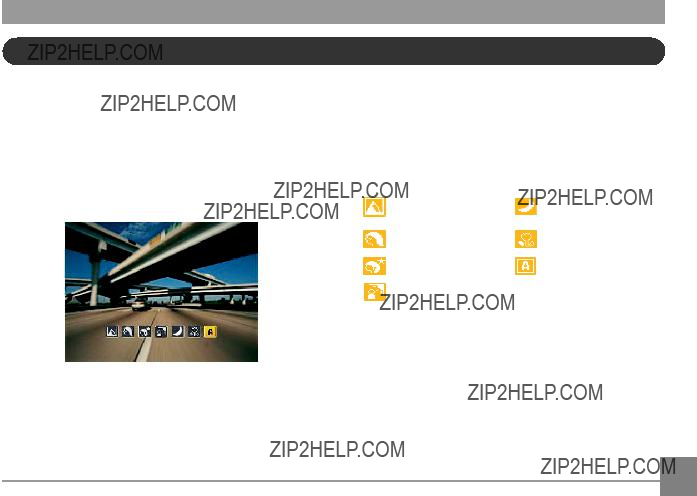
Auto Scene Mode (ASCN)
In the "ASCN" mode, different recording conditions are detected intelligently and the most suitable settings will be automatically selected. With "ASCN" you can always take good pictures easily.
To use "ASCN":
1.Turn the mode dial to "ASCN", LCD display showing the following diagram.
2.Hold the camera steadily and aim at the subject. The optimum scene mode will be identified automatically.
3.Press the Shutter button halfway down to focus.
4.Press the Shutter button all the way down to take the picture.
Landscape Mode
For landscapes, ASCN will automatically adjust the exposure to match the background.
Portrait Mode
For portraits, ASCN will automatically adjust the exposure and skin tones to give clear pictures.
33

Night Portrait
When you shoot portraits at night, or in low light conditions, ASCN will automatically adjust the exposure for people and night scenes.
Backlit Portrait
When the sun or any other light source is behind you, ASCN will automatically adjust the foreground exposure to produce good pictures.
Night Landscape Mode
For night scenes, ASCN will automatically increase the ISO value to compensate for low light.
Macro Mode
To capture object detail for
Auto Mode
The camera will automatically adjusts the exposure and focus to ensure good pictures.
Panorama
Panorama Mode allows you to create a panoramic picture. The camera will automatically compose a panoramic picture using the individual shots that you take.
Follow these steps to create a panoramic picture:
1.Turn the mode dial to the Panorama Mode. Then enter the Photo Setup to Select either Auto Stitching or Manual Stitching.
2.Use the Left/Right buttons to specify the direction of picture taking, and then in 2 seconds the panoramic sequence will commence automatically.
3.Compose the first view of the panoramic picture on the
LCD screen and press the Shutter button to capture.
4.Following are different steps for the Auto Mode and
Manual Mode selected for the Panorama Mode in the Photo Setup.
34
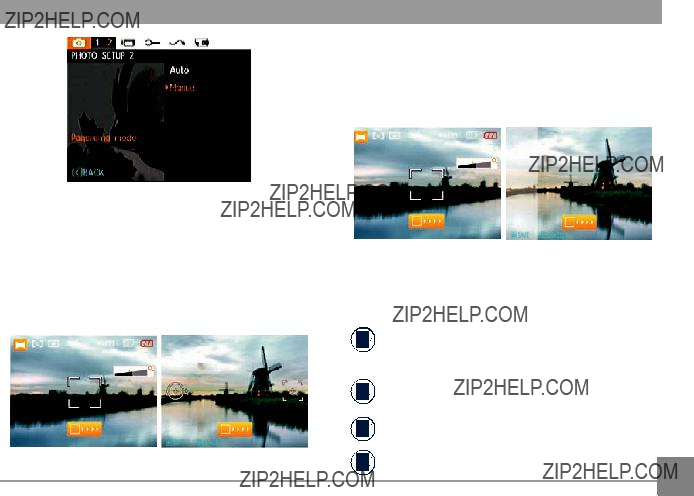
When Using Auto Mode:
After the first shot is taken, two target icons will appear on the left and right side of the LCD screen. Pan the camera and the circle icon on the screen will move towards the square frame icon. When the circle icon and square frame become green once they overlap, the camera will capture the next picture automatically. Repeat the same step for the third picture to finish the stitching.
When Using Manual Mode:
After the first shot is taken, the
Shutter button to capture and finish manual stitching.
5.The camera will then stitch the pictures into a panorama automatically.
6.Press the playback button to enter Playback mode and review the panorama result.
After taking a Panoramic picture press the func/ok but- ton to save and exit or press the Delete button to cancel and exit.
Flash Mode,
Pictures cannot be deleted, nor the zoom adjusted until the series is finalized.
Panorama Mode can stitch 2 or 3 maximum pictures.
35

Manual Scene Mode (SCN)
In Manual Scene mode, you can select from a total of 12 scene types to match your needs. You just need to select the right scene for the occasion and the camera will automatically adjust to the optimal settings for you.
To enter the Scene Mode, turn the mode dial to Manual Scene mode. The Scene Mode palette appears.
Select a scene using the Left/Right button and press the button.
button.
Sport
For shooting
Indoor
For shooting people indoors. Clearly show background and atmosphere.
36

Snow
Suitable for snowy landscape. Camera automatically adjusts and corrects exposure value (EV).
Fireworks
For shooting at night and fireworks. Shutterspeed is slower than normal. (Use of tripod is recommended)
Museum
For shooting in museums or places where flash is not allowed.
Night landscape
For shooting night scenes. Use of tripod is recommended.
Children
Suitable for photographing children and pets. The flash shuts off automatically in order not to disturb the subject being photographed.
Leaf
For shooting plants. Vivid reproduction of green.
Sunset
For shooting sunsets. Vivid reproduction of red and yellow.
Glass
Suitable for photographing objects behind glass or window.
Landscape
For shooting landscapes. Vivid reproduction of green and blue.
Night portrait
For shooting portraits with night scenes as background.
37

1.After selecting the scene type, press the button to activate.
button to activate.
2.To select a different scene type, press the button to enter the main function menu. Then press it again to return to the to Scene selection menu.
button to enter the main function menu. Then press it again to return to the to Scene selection menu.
The main function menu also allows you to adjust the image quality and image size. Please refer to the "Advanced Functions Menu" section on page 25 for detailed instructions.
Stabilization Mode
This mode can help reduce photo blur caused by hand shake, low light and slow shutter speed
Use stabilization mode in dark environments or when in slow shutter speed
Shooting in a windy or unstable environment (such as a moving vehicle) may cause blurred images.
38

Face Detection
The Face Detection mode will detect and focus on faces of persons during picture shooting so that the faces will be clearer.
1.In Shooting Mode, press the Left/Face Detection button to
turn on the Face Detection and an icon (  ) appears on the LCD.
) appears on the LCD.
2.Hold the camera securely, and point the camera towards the subject to start the face detection process. When the camera detects a face, a white rectangular frame will be drawn around the face. (Note: For best results, the face of the subject should be relatively large on the LCD screen, and the subject should be facing the camera as front on as possible.)
3.Press Shutter halfway to focus on the subject.
4.Press Shutter fully to capture the image.
5.Press the Left/Face Detection button to turn off Face
Detection.
39
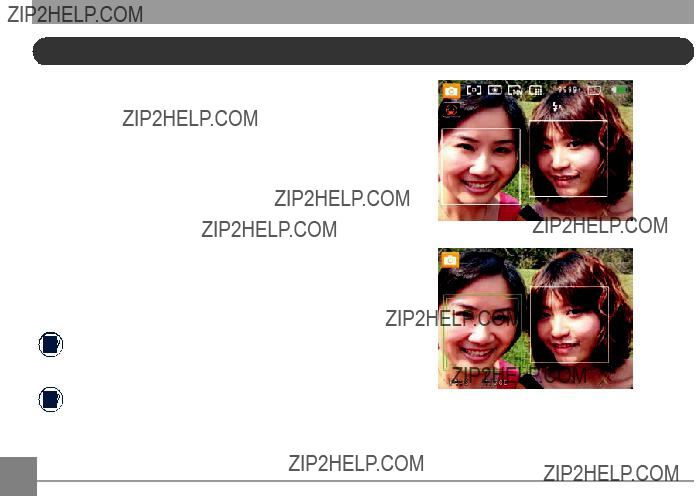
Smile Detection
With the camera's new "Smile Detection" feature, which automatically detects and captures a person smiling, you'll never miss a smile.
1.In Shooting Mode, press the Left/Face Detection button to
turn on Smile Detection and an icon (  ) appears on the LCD.
) appears on the LCD.
2.Point the camera at the subject until the subject's face is detected and bracketed by a square box. Press the Shutter button all the way down and release the Shutter button. The camera will now 'wait' for the subject to smile.
3.When the subject smiles, the camera will automatically release the shutter and capture the photo.
4.To disable Smile Detection function, please press Left or Shutter button.
A face must be detected by the camera in order for smile detection to function correctly.
For optimal detection results, the subject should be framed to occupy most of the screen space.
40
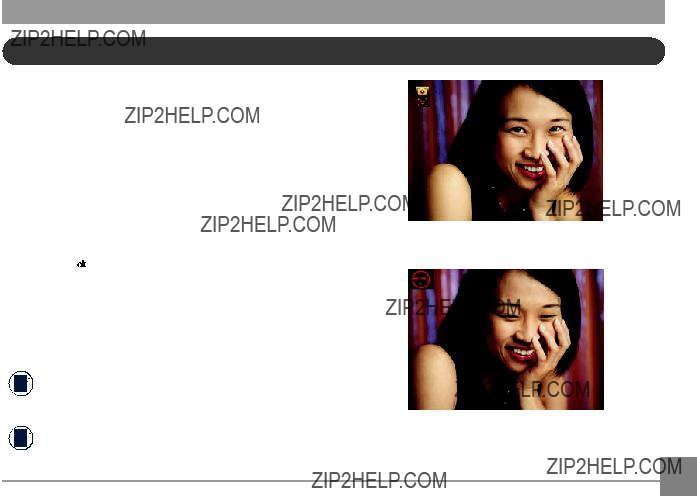
Blink Detection
The Blink Detection feature is on by default, and after taking each photo, a warning message will pop up if a blink had been detected in the photo.
1.In any Still Shooting modes, press the 
 button to enter the photo menu.
button to enter the photo menu.
2.Switch between different Photo Setup menus and Camera
Setup menus using the Left/Right button, and select the ???Blink Detection??? setting using the Up/Down button.
3.Use the Right navigation buttons to enter the submenu, and select "On" option.
4.Press the  button to confirm the setting and exit the menu.
button to confirm the setting and exit the menu.
5.The "Blink detection" indicator appears on the LCD.
6.Press the Shutter button fully to capture the image. If someone has blinked, the camera will show blink detection warning message right after.
A face must be detected by the camera in order for smile detection to function correctly.
For optimal detection results, the subject should be framed to occupy most of the screen space.
41

PLAYBACK
Viewing Photos and Videos
To view the captured photos and video clips on the LCD screen:
1.Press  button to go to the Playback mode. The last recorded photo or video clip is displayed.
button to go to the Playback mode. The last recorded photo or video clip is displayed.
2.Use the Left/Right navigation buttons to scroll through the photos or video clips stored in the internal memory or memory card.
3.To play a selected video clip, press the button to enter the movie playback mode.
button to enter the movie playback mode.
During video playback, the operating instructions will appear on the screen. Press the Left/Right button, and press the button for confirmation.
button for confirmation.
 1
1
 2
2  3
3
 4
4
 5
5
 6
6
The operating instruction icons are as follows.
42

During video playback, you can press the Up/Down button to adjust the volume.
Thumbnail View
In Playing Mode, adjust the Zoom button/zoom lever to the side 
 , so as to display thumbnail of photo or video in the screen.
, so as to display thumbnail of photo or video in the screen.
1.Display thumbnail with 2x2, 3x3 and 4x4 by switching the
Zoom button/zoom lever.
2.Use Up/Down/Left/Right to select a photo or video clip to view.
If the  indicator appears on the LCD, then a movie file is currently being displayed.
indicator appears on the LCD, then a movie file is currently being displayed.
Press the button to restore a preview icon to its original image size.
button to restore a preview icon to its original image size.
43

Using Zoom Playback (for still pictures only)
When playing photo, you can also use Zoom button/zoom lever to zoom in it 8 times.
1.Press  button to go to the Playback mode.
button to go to the Playback mode.
2.Use the Left/Right navigation buttons to select a photo to magnify.
3.Adjust the Zoom button/zoom lever to the side  to zoom in the photo.
to zoom in the photo.
4.Use the Zoom buttons to zoom in and out. The zoom indication and the frame of the whole photo shall display on the screen.
5.Use the navigation buttons to pan across the image.
6.Press the  button to return the image to its original scale.
button to return the image to its original scale.
 Movie images cannot be magnified.
Movie images cannot be magnified.
44

Using the Delete Button
In Playback Mode, you can press the Down/Delete button to delete pictures or videos.
To delete pictures or videos:
1.Press  button to go to the Playback Mode.
button to go to the Playback Mode.
2.Select a picture or video clip you want to delete with the Left/Right button.
3.Press the Down/Delete button and the delete screen appears.
4.Select Yes or Back with Up/Down button and press the  button for confirmation.
button for confirmation.
 Erased photos/video clips cannot be recovered.
Erased photos/video clips cannot be recovered.
Please refer to page 56 for instructions on the Delete Menu options.
45

USING THE MENUS
Still Menu
Mode: M
In any of the above Still Picture Modes, press the

 button to go to the Still Picture menu.
button to go to the Still Picture menu.
To adjust each setting:
1.In the Still Picture menu, switch between different Photo
Setup or Camera Setup pages using the Left/Right button, to select the page with the function you want to adjust and press the Down button.
2.Press the Up/Down buttons to select the function.
3.Press the Right button to go to the submenu.
4.Press Up/Down button to select an option or press the Left or

 button to return to the menu.
button to return to the menu.
5.Press the button for confirmation and exit the menu.
button for confirmation and exit the menu.
After selecting a function, you can press the Up button to return to the Still Picture menu for other Photo Setup or Camera Setup pages. Or you can press the Down button several times to move to the next setup menu page.
Refer to the following pages for more details about each setting.
46

AF Mode
Use this setting to control the
Two options are available:
???
???
This option can turn on or turn off AF assist lamp. It can strengthen focusing to turn on the AF assist lamp in dark conditions.
47

Continuous AF
After Continuous AF is turned on, the camera will adjust focus automatically in response to any camera or subject move- ment.
Expo Metering (Exposure Metering)
Use this setting to select an area for the exposure to be obtained.
Three options are available:
???Spot
???
???AiAE (Artificial Intelligence AE)
48
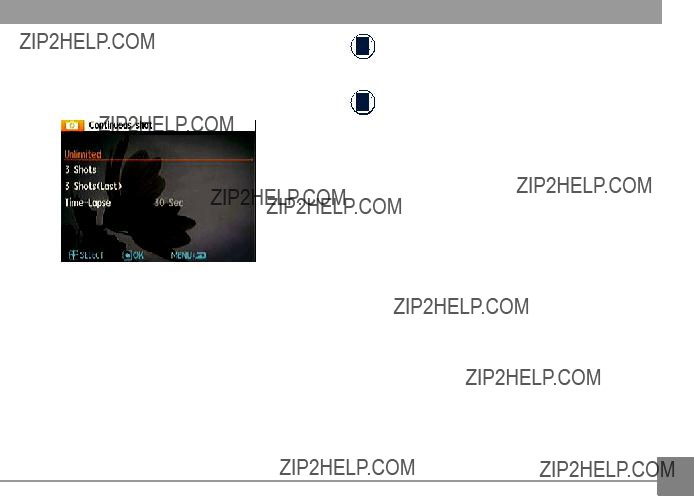
Continuous Shot
Use this setting to perform continuous shooting. Once in this mode, you must continuously hold down the Shutter button to use this function.
Four options are available:
???Continuous shooting: Press and hold the shutter to shoot continuously until you release the shutter or when the memory card has run out of space.
???3 shot: Capture up to 3 consecutive pictures.
???3 shots (Last): Capture pictures continuously until the Shutter button is released but only the last 3 shots are recorded.
???
The flash is designed not to work in this mode in order to enable quick succession of shots.
Continuous Shot can only be selected in
49

Date Imprint
Include a Date/Time stamp in the photo image.
???Off
???Date
???Date and Time
Quick Review
This setting refers to the quick photo review immediately after taking a picture. The picture stays on the LCD screen for an adjustable period of time.
Four options are available:
???Off
???1 sec
???2 sec
???3 sec
50

Digital Zoom
Use this setting to enable or disable the digital zoom function. When disabled, only the optical zoom is enabled.
Digital Zoom indicator:
???Off: gray color.
???On: reddish color.
Slow Shutter
In Slow shutter mode, the shutter will remain open as long as the Shutter button is pressed. This gives you complete control over the duration of exposure. (The slow shutter mode is available only in M manual mode.)
???Manual : To set a long exposure time between 2~30 sec.
The use of tripod is recommended for prolonged exposure.
51

Blink Detection
The Blink Detection feature is on by default, and after taking each photo, a warning message will pop up if a blink was detected in the photo.
Movie Menu
Mode:
In the Movie Mode, press the

 button to go to the corre- sponding Movie menu.
button to go to the corre- sponding Movie menu.
To configure each setting:
1.In the Movie menu, switch between the Movie Setup or different Camera Setup pages using the Left/Right button, select the page with the function you want to adjust and press the Down button.
???Off
???On
2.Press the Up/Down button to select the function and press the Right button to go to the submenu.
52

Continuous AF
After Continuous AF is turned on, the camera will adjust focus automatically in response to any camera or subject movement.
3.Press the Up/Down button to select an option or the Left or

 button to return to the menu.
button to return to the menu.
4.Press the button for confirmation and exit the menu.
button for confirmation and exit the menu.
Refer to the following pages for more details about each setting.
53
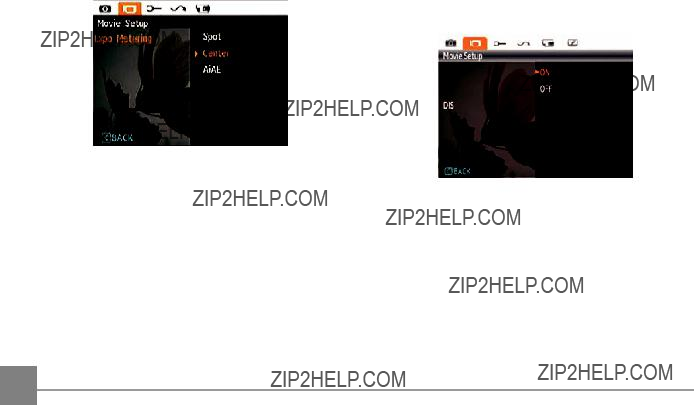
Set metering mode for various lighting conditions.
Using this function can ensure the maximum stability of the screen when recording video.
Three options are available:
???Spot
???Center
???AiAE (Artificial Intelligence AE)
54

Playback Menu
Mode : 
In Playback mode, press the

 button to enter the Play- back menu.
button to enter the Play- back menu.
Please refer to the following sections for detailed instructions on the various menu options.
Protect
To prevent any pictures or videos from being accidentally erased, use this setting to lock one or all of the files.
To protect/unprotect a picture or video:
1.Press  button and find the picture or video you want to protect by using Left/Right button. Once it is displayed on the screen, go to the Playback menu, select Protect settings and press the Up/Down button to make your selection.
button and find the picture or video you want to protect by using Left/Right button. Once it is displayed on the screen, go to the Playback menu, select Protect settings and press the Up/Down button to make your selection.
2.Press the Up/Down button to select the protection setting option and press the Right button to go to the submenu.
55

3.Use the Up/Down navigation buttons to select One to protect this picture/video, or select All to protect all pictures/videos in the internal memory or memory card. Then press the Right navigation button to enter the submenu.
4.Press the  button to select Yes to lock. For locked picture/video, use Unlock option to unlock it.
button to select Yes to lock. For locked picture/video, use Unlock option to unlock it.
5.A key (  ) icon will appear on the top of the screen to indicate that the picture/video is protected.
) icon will appear on the top of the screen to indicate that the picture/video is protected.
6.Select Reset on the Protection setting to cancel protection for all files that have been placed in the protected mode.
Delete
There are two ways to delete files.
???Delete One:
1.On the Delete setting, select Delete One and then press the Right button.
2.Using the Left/Right buttons, locate the photo or movie file to be deleted. Select Yes (to delete file) or No (to return to the previous menu) using the Up/Down buttons, then press the  button to confirm.
button to confirm.
56

??? Delete All:
1.On the Delete setting, select Delete All and then press the Right button.
2.Using the Left/Right buttons, select Yes (to delete all files) or No (to cancel and return to the previous menu).
The ??? ??? indicator means a file is protected. File protection must be removed first before a file can be deleted.
??? indicator means a file is protected. File protection must be removed first before a file can be deleted.
 Deleting files will cause DPOF settings to be reset.
Deleting files will cause DPOF settings to be reset.
DPOF (Digital Print Order Format)
DPOF allows you to record your selection of pictures that you would like to print, and will save your selection in the memory card, so that you can simply hand your memory card to a photo kiosk without having to tell them in person which photos you would like to print.
57

Trim
The Trim setting allows you select an area of the photo you want to keep and then save it as a new photo.
To trim a picture:
1.Select the Trim setting from the  menu.
menu.
2.Using the Left/Right buttons, locate the photo that you want to crop and have it displayed on the LCD.
3.Use the zoom buttons and navigation buttons to adjust the trimming box to fit the location and size of the new picture.
4.Press the Shutter button to save what you see on the LCD
screen as a new picture, or the 
 button to cancel and return to the Playback menu.
button to cancel and return to the Playback menu.
With the HDR function, pictures that may be overexposed may be corrected to optimize the highlights and lowlights captured to more accurately represent the real scene.
1.Select HDR setting in  menu as described previously.
menu as described previously.
2.Press Left and Right button to find picture you want to optimize and then select Confirm to perform HDR optimization or select Return to go back to Playback menu.
3.After using HDR function, the image will be saved as a new file, and the original file is still stored in the memory.
58
The image can not be clipped again when it is clipped to 640X480.

Resize
This setting allows you to resize a picture to a specified resolution, and saves it as a new picture.
1.Select the Resize setting from the Playback menu as described previously.
2.Use the Left/Right navigation buttons to select a picture to resize.
3.Use the Up/Down navigation buttons to select a resolution (1024X768 or 640X480) to resize the image or
Back to cancel and return to the Playback menu.
4.Press the  button to confirm the setting.
button to confirm the setting.
Resizing an image creates a new file that contains the image in the size you select. The file with the original image also remains in memory.
Rotate
You can use this setting to change the picture orientation of the picture.
1.Select the Rotate setting from the Playback menu as described previously.
2.Use the Left/Right navigation buttons to select a picture to rotate.
3.Use the Up/Down navigation buttons to select the direction for rotation or Back to cancel and return to the
Playback menu.
4. Press the  button to confirm the setting.
button to confirm the setting.
59

Use this setting to remove
1.Select the
2.Use the Left/Right button to select the picture from which the
3.Use the Up/Down navigation buttons to select Yes to fix the selected image or Back to cancel and return to the
Playback menu.
4. Press the button to confirm the setting.
button to confirm the setting.
For best results, the face of the subject should be relatively large on the LCD screen, the subject should be facing the camera as front on as possible, and the red eyes should be as large as possible.
60
Media Center
Mode: 
Press 

 button in Playback mode to enter Media Center menu.
button in Playback mode to enter Media Center menu.
Refer to the following sections for details of every setting.

Slideshow
This setting allows you to view all the stored pictures as a slideshow.
1.Select the slideshow menu, press the right button to enter the options menu.
2.Use the Up/Down navigation buttons to select Effect,
Interval time, or Repeat and use the Left / Right navigation buttons to adjust the setting.
3.Use the Up/Down navigation buttons to select Start to run the slideshow or Cancel to return to the Playback menu.
4.Press the button to confirm the setting.
button to confirm the setting.
Wallpaper Settings
Use this setting to select your favorite picture to use as a background on the LCD screen.
1.Use this setting to select your favorite picture to use as a background on the LCD screen.
2.Press Up/Down button to select wallpaper settings, welcome screen setting or default, and press Right button to adjust setting value.
3. Press button to confirm setting.
button to confirm setting.
61

2.Press Up/Down button to select Natural or Vivid, and press  button to confirm the setting.
button to confirm the setting.
62
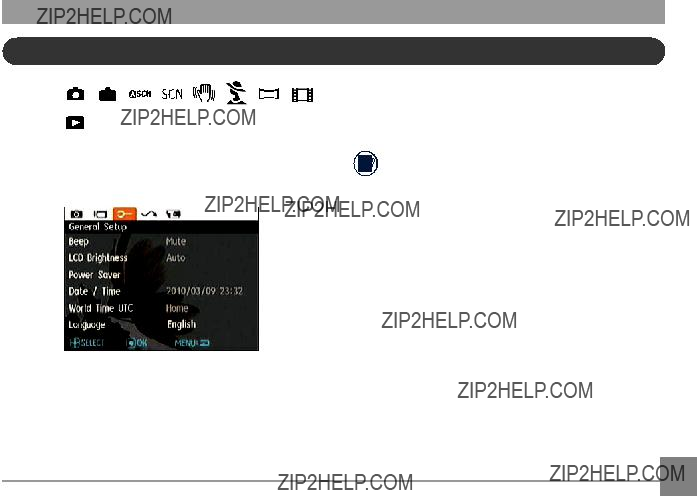
Setup Menu
Mode :  M
M
The Setup menu for the camera is available in all modes. Each menu page can be selected by pressing the
 button and switching between menus with the Left/Right button.
button and switching between menus with the Left/Right button.
To adjust the settings:
1.Select the menu page with the function you want to adjust and press the Down button.
2.Switch between different functions with the Up/Down button.
3.Press the Right button to enter the submenu.
After selecting a function option, you can press the Up button to return to the menu for other Camera Setup pages. Or you can press the Down button to switch to the next menu page.
Refer to the following pages for more details about each setting.
63

Beep
Use this setting to adjust the volume of beep when buttons are pressed and change the tones for Shutter button,
To change this setting:
1.Select the Beep setting from the Setup menu as described previously.
2.Use the Up/Down navigation buttons to switch between volume, shutter tone, key tone,
3.Press the Right button, press the Up/Down button to
adjust volume and change tone, and press the  button to confirm setting.
button to confirm setting.
LCD Brightness
Use this setting to adjust the brightness of your LCD screen.
1.Select the LCD Brightness setting from the Setup menu as described previously.
2.Select auto or adjust the brightness level using the
Left/Right button, and press the  button to confirm the setting.
button to confirm the setting.
64

Power Saver
This setting allows you to save power and get the maximum possible running time for your battery. Follow the steps below to turn off the LCD screen and camera automatically after a period of inactivity.
1.Select the Power Save setting from the Setup menu as described previously.
2.Press the Up/Down button to select the power items for the screen and camera and press the Right button.
3.Press the Up/Down button to adjust the selected item. Both items have the following options:
???Turn off the LCD:
30 sec, 1 min, 2 min, and off.
???Turn off the camera:
3 min, 5 min, 10 min, and off.
4. Press the  button to confirm.
button to confirm.
Zone
The Zone setting is a useful function on your overseas trips. This feature enables you to display the local time on the LCD screen while you are overseas.
1.Select the Zone setting from the Setup menu as described previously. The world time screen appears.
2.Use the Up/Down navigation buttons to switch between the hometown (  ) and travel destination (
) and travel destination (  ) fields.
) fields.
3.Use the Left/Right navigation buttons to select a city
close to the desired time zone. Then press the  button to confirm.
button to confirm.
65

File and Software
Format Memory
Please note: formatting enables you to delete all contents in the memory card and
See ???Setting the Date and Time??? section on page 19.
Language
See ???Setting the Language??? section on page 20.
3. The current media is formatted.
66
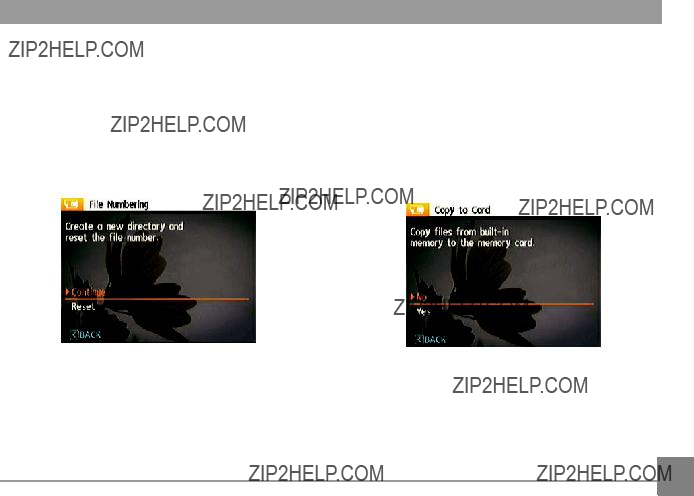
File Numbering
After you take a picture or video clip, the camera will save it as file that ends with a serial number. You can use this item to choose whether the file is serially numbered or begins with 1 and is saved in another folder on the memory card.
1.Select the File Name in File and Software menu.
2.Select the option with the Up/Down button and press the
 button for confirmation.
button for confirmation.
Copy to Card (Copy internal memory to memory card)
Use this setting to copy the files stored in the internal memory to the memory card.
1.Select the Copy to memory card in File and Software menu.
2.Use the Up/Down navigation buttons to select Yes or No. Then press the  button to confirm.
button to confirm.
67

Reset Settings
Use this setting to restore the camera to its default settings.
1.Select the Reset setting in File and Software menu.
2.Use the Up/Down navigation buttons to select Yes or No. Then press the  button to confirm.
button to confirm.
FW Version (Firmware Version)
Use this setting to view the current camera firmware version.
1.Select the FW Version in File and Software menu.
2.If SD card contains a new version of firmware, please upgrade accordingly as necessary.
To update to the latest firmware version, you can go to the following website:www.ge.com/digitalcameras and look under Support.
68

CONNECTIONS
Video System
Use this setting to determine your video system in the current area.
1.Select the Video System in Connection Setup menu.
2.Use the Up/Down navigation buttons to select NTSC or
PAL. Then press the button to confirm.
button to confirm.
The video output signal can be switched to NTSC or PAL to accommodate different regional standards. The appropriate setting will vary between regions.
NTSC: USA, Canada, Taiwan, Japan, etc.
PAL: Europe, Asia (excluding Taiwan), Oceania, etc.
Note: The TV output will not display properly if an incorrect video system is selected.
69

Connecting to a PC
Use the USB cable and ArcSoft software
Setting the USB mode
Since the camera???s USB port can be set to connect with either a PC or a Printer, the following steps will allow you to ensure that the camera is correctly configured to connect with a PC.
1.Press the button and use the Up/Down navigation buttons to select USB Connect, and then press the Right navigation button.
button and use the Up/Down navigation buttons to select USB Connect, and then press the Right navigation button.
2.Use the Up/Down navigation buttons to select PC.
3.Press the button to confirm the setting.
button to confirm the setting.
Transferring files to your PC
The computer will automatically detect the camera as a removable drive.
By using the USB cable, you can transfer the captured photos and videos to a PC. Follow the steps below to connect the camera to a PC.
1.Start a computer to which ArcSoft software has been installed.
2.Make sure both the camera and PC are turned on.
3.Connect one end of the supplied USB cable to the USB/AV OUT port on your camera.
4.Connect the other end of the cable to an available USB port on your PC.
70

5. Disconnect the camera once transfer is completed.
If the USB option is set to [PC] :
Turn the camera off and disconnect the USB cable.
If the USB option is set to [PC (PTP) ] :
Remove the camera from the system as described below before turning the camera off and disconnecting the USB cable.
Windows operating system (Windows 2000, Windows XP, Windows Vista, Windows 7.)
Click the [Safely remove the hardware] icon and remove the USB connector according to the appeared menu.
Macintosh
Drag the untitled icon to the Trash. ("Untitled")
71

Connecting to a PictBridge Compatible Printer
PictBridge allows printing images from a memory card in a digital camera directly to a printer, regardless of brand. To find out if a
printer is PictBridge compatible, simply look for the PictBridge logo on the packaging or check
the manual for specifications.With the PictBridge function on your camera, you can print the captured photos directly with a PictBridge compatible printer using the supplied USB cable, without the need for a PC.
Setting the USB mode
Since the camera???s USB port can be set to connect with either a PC or a Printer, the following steps will allow you to ensure that the camera is correctly configured to connect with a
Printer.
1.Go to the camera setting menu, select USB connection with the Up/Down button, and press the Right button.
2.Use Up/Down to select Printer.
3. Press the button to confirm the setting.
button to confirm the setting.
After the camera is reset, it will switch to PC mode automatically from USB mode.
72

Connecting the camera and printer.
1.Make sure both the camera and printer are turned on.
2.Connect one end of the supplied USB cable to the USB port on your camera.
3.Connect the other end of the cable to the USB port on the printer.
If the camera is not connected to a PictBridge compatible printer, the following error message appears on the LCD screen.
The above error message would also appear if the USB mode were set incorrectly, in which case you should disconnect the USB cable, check the USB mode settings, ensure that the Printer is turned on, and then try connecting the USB cable again.
73

Using the PictBridge Menu
After setting the USB mode to Printer, the PictBridge menu appears.
Select a menu item with the Up/Down button and press the Right button or button to enter the item.
button to enter the item.
Refer to the following sections for more detailed information on each setting.
Print with date
If you have set the date and time of your camera, the date and time will be recorded and saved with each photo you take.
1.Select Print with date from the PictBridge menu. The following screen appears.
2.Use the Left/Right navigation buttons to scroll through the photos.
74

3.Use the Up/Down navigation buttons to select the number of prints for the current displayed photo.
4.Press the button and the following screen appears.
button and the following screen appears.
5.Select Yes to confirm the printing, or Cancel. Then press the button.
button.
Print without date
Use this setting to print the photos without dates on them.
1.Select Print without date from the PictBridge menu. The following screen appears.
2.Use the Left/Right navigation buttons to scroll through the images.
3.Use the Up/Down navigation buttons to select the number of prints for the current displayed image.
4.Press the button and the following screen appears.
button and the following screen appears.
75

5.Select Yes to confirm the printing, or Cancel. Then press the  button.
button.
Print index
You can use this setting to print all indexes to show all the photos currently in your camera.
1.Select Print index from the PictBridge menu. The following screen appears.
2.Select Yes to confirm the printing, or Cancel. Then press the  button.
button.
76
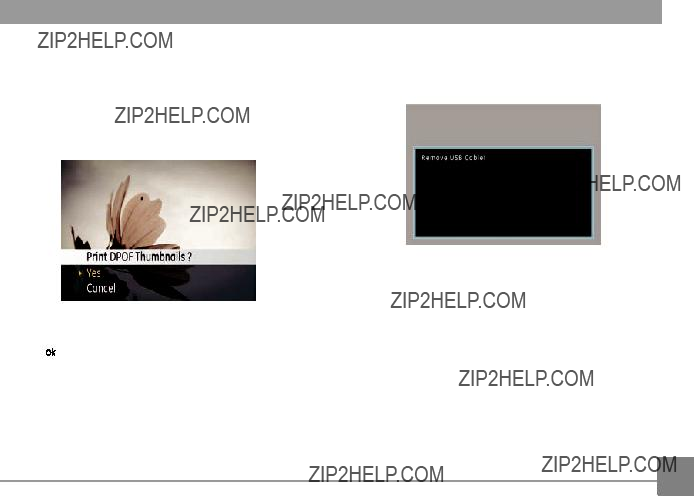
Print DPOF (Digital Print Order Format)
To use DPOF printing, you must make the selection of photos for printing using the DPOF settings before hand. See ???DPOF??? section on page 57.
1.Select Print DPOF from the PictBridge menu. The follow- ing screen appears.
2.Select Yes to confirm the printing, or Cancel. Then press the  button.
button.
Exit
To exit the PictBridge menu, select Exit. The ???Remove USB cable??? message will be displayed.
Disconnect the USB cable from the camera and printer.
77

APPENDICES
Specifications : A1255 / A1455
 Design and specifications are subject to change without notice.
Design and specifications are subject to change without notice.
78

79

80

81
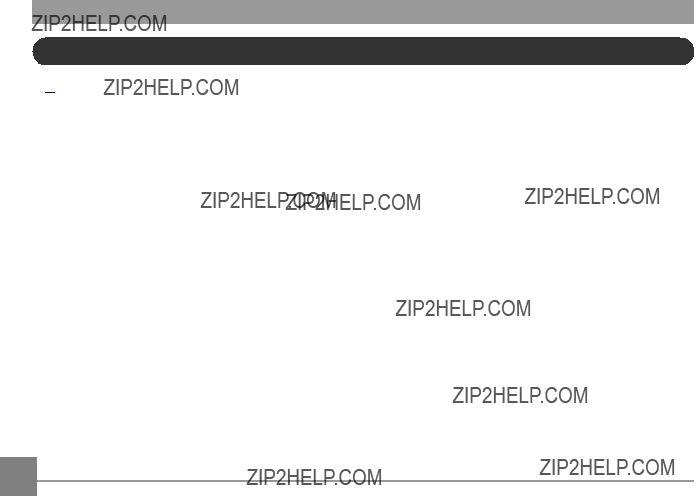
Specifications : J1455
 Design and specifications are subject to change without notice.
Design and specifications are subject to change without notice.
82

83

84

85

Error messages
86

87

Troubleshooting
Camera does not turn on.
???The battery has run out.
???The battery is not inserted cor- rectly.
??? Replace with a fully charged battery.
Camera turns off suddenly during operation.
??? Unlock the memory card.
88

89

http://www.ge.com/digitalcameras